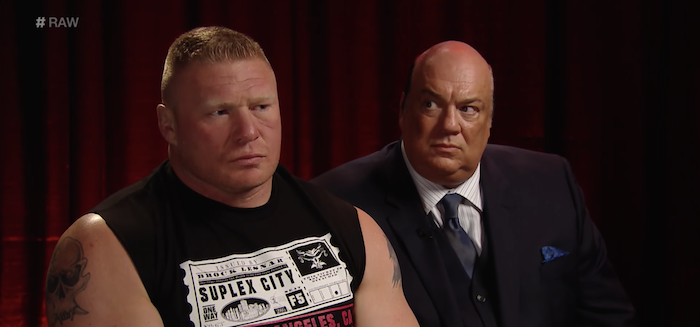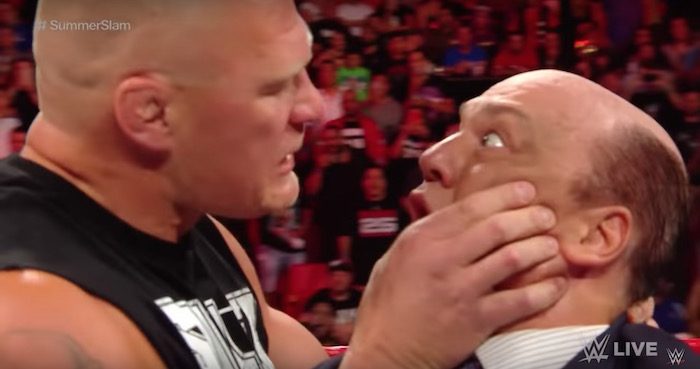
Picture, if you will, a middle-aged white man; broken, disheveled, perhaps even remorseful. A character who’s spent years pursuing a twisted ideal that now pushes back, struggling to accept this reality as he re-calibrates his place in the world.
It sounds like a “prestige” American cable drama, doesn’t it? In the case of character Paul Heyman however, a slimy lawyer played by producer and inadvertent actor Paul Heyman, it happens to be a fixture of American wrestling. No, not the Olympic sport. The trashy, “lowbrow” one. The one broadcast on Monday nights, where women in skimpy outfits would mud-fight for rowdy crowds while men bashed each other’s skulls in with folding chairs for our entertainment. At least, that’s how things used to be.
Watch a clip from this week’s episode of WWE Monday Night Raw. No context required, other than the fact that last week, Paul Heyman’s friend and long-time client, former UFC fighter Brock Lesnar, put their relationship into words while grabbing Heyman by the throat: “Let’s get something straight. We’re not friends, Paul. You work for me. I don’t work for you.”
This follow-up scene, shot in the form of a tell-all interview, features one of the best performances currently on television. Not only as a self-contained moment of character, but part of a larger story that’s been going on for 16 years:
Would it surprise you if I said there had been Emmy talk about this performance all week long? I’m not in the habit of award prognostication, but until a few months ago, it would’ve surprised me too. And yet, WWE’s creative direction in recent years — often called the “PG era,” where the aim has been mainstream acceptance — and their recent billion-dollar deal with Fox seem to indicate a bid to be taken more seriously. The company even had its first ever Emmy submission and campaign earlier this year. Stranger things have happened, but regardless of gold statues or lack thereof, Heyman’s long-running performance, which rides the line between melodrama and subtlety, is a great opportunity to talk about acting itself.
A Brief History
The modern age of “Sports Entertainment” brought with it both a scaling back on the carnage and a renewed focus on women as competitors rather than sex objects, but an effect of this shift in the streaming age that tends to be glossed over is the evolution of its storytelling. Not just what stories are told, but rather, how. For the last seven years, WWE and the wrestling industry at large have leaned in to the artifice, smashing the fourth wall by bringing audiences into wrestlers’ personal lives. Publicly breaking character or “kayfabe,” once a cardinal sin, is the new norm (zombie-mortician-Hell-wizard The Undertaker now has an Instagram) and stories frequently veer into metatext based on what fans have heard has been going on behind-the-scenes, building on expectations. In 2014, fans began to disrupt shows by chanting the name of a beloved wrestler, Daniel Bryan, who wasn’t getting enough opportunities, so WWE dramatized this by having fans occupy the ring.
Most recently, WWE Universal Champion Brock Lesnar showed up at the UFC — wrestling’s violent, unscripted, combat-sport cousin — further fueling rumours of his return to Mixed Martial Arts. Wrestling fans don’t normally like when their champ turns their backs on them; Dwayne “The Rock” Johnson was a villain shortly before his departure for Hollywood in 2004, and a similar phenomenon has been taking place with Lesnar these past few months. As a big box-office draw, Lesnar doesn’t need to adhere to WWE’s rigorous schedule (his expensive part-time contract allows for a small handful of appearances) and his absence doesn’t sit well with fans. It wouldn’t with fans of any other show; people like to see their favourite characters actively involved in the narrative.
Where does Paul Heyman fit in to all this? He considers himself Lesnar’s friend, though he fills the on-screen role of the ringside manager, referring to himself as Lesnar’s “advocate,” as he cheers him on from the sidelines. Usually, his function would end there, but Lesnar’s the strong, silent type, while Heyman cracks wise and puts the verbal beat down on anyone who tries to step to the champ. Their dynamic is simply made for television.
Generally, making it in wrestling requires the ability to perform both in-ring and on the microphone. You have to be a stellar physical storyteller and stunt performer, but you also have to be able to cut “promos” that advance the narrative by speaking to both other wrestlers and to the audience at large. The Rock had these abilities in droves, as does WWE’s current flagship performer John Cena, though both men would eventually turn their attention to the big-screen (see also: Dave Bautista).
Unlike The Rock and Cena though, both of whom Lesnar has decimated in-ring, Lesnar’s mic work isn’t anything to write home about. He’s stiff, and he isn’t exactly a people person either. Usually, this would mean fading into obscurity after several months, but between 2002 and 2004, Lesnar, a legitimately big and scary dude, was rightly billed as “the next big thing.” The monstrous 25-year-old, who had “champion” written all over him, was thus paired with long-time wrestling producer Heyman, who would do most of the talking for him. And boy, can Heyman talk. He once improv’d his way around real-life proposal in the crowd, turning it into an opportunity to promote his client.
Lesnar would eventually leave the company (the fans booed him out the door as soon they found out), though his return in 2012 would see the Lesnar-Heyman pairing reach its full potential. By this point, Lesnar had made a career for himself as an actual fighter, and a force to be reckoned with in UFC. All he needed to do was stand in the middle of the ring to look intimidating. A returning Heyman would often introduce him from somewhere off-stage, beginning “Ladies and gentlemen, my name is Paul Heyman” in his familiar, obnoxiously cocky cadence, as the crowd went wild with anticipation. Any scripted feud between Lesnar and another character would find its legs whenever Heyman was on the microphone, extolling the virtues of the “reigning, defending, undisputed” champion with such gusto that crowds began to growl “Brrrrrrrrock Lesnar” in unison alongside him.
Lesnar’s physical stature, complimented by Heyman’s oratorical prowess, is one of wrestling fandom’s favourite pairings, even though it’s one we rarely see. The prospect of Lesnar returning to the UFC octagon is certainly disappointing, and while Heyman could perhaps find a new “client” as he has in the past, few non-action moments in the WWE match up to the sheer majesty of a man so dedicated to his protégé that he’s often willing to put his job on the line simply to intimidate an opponent or fictional figure of authority…
Which is precisely why the ongoing culmination of their saga is so heartbreaking. In this week’s scene, Heyman tells us what’s at stake without having to say it — or rather, without being able to. His signature “reigning, defending” catchphrase trails off mid-sentence. We may never hear it again.

Heyman, the Storyteller
Wrestling is an inter-textual medium. Currently, one of the best in-ring stories is unfolding between two former best friends, Johnny Gargano and Tommaso Ciampa (on WWE’s developmental, streaming-only promotion, NXT), whose current matches harken back not only to dangerous set-pieces, but to subtle moments between the pair two years prior, like sitting down to reflect on their relationship in the middle of a match. Like any good long-term storytelling, echoes matter in wrestling. It makes sense in logistical terms — audiences need a sense of continuity if they’re to tune in to the next episode — but for those scrutinizing every word and every frame in search of emotional investment, Heyman knows exactly which buttons to push.
In the mid-‘90s, Heyman was responsible for WWE’s (then WWF’s) Philadelphia-based rival Extreme Championship Wrestling, or ECW, an acronym still chanted by fans today despite the company having gone out of business in 2001. The image non-fans have of American wrestling as a hyper-violent blood sport? That’s partially Heyman’s doing. The “hardcore” style of wrestling, involving weapons and death-defying leaps off ladders works as self-contained carnage, but the carnage in turn works as a tool of storytelling because of the anticipation. A table is placed in a certain position. Wrestlers battle it out atop a nearby ladder. Maybe they get back on solid ground at first, but eventually, they return to the top of ladder, and the crowd waits eagerly for one of them to fall through it. Setup. Reminder. Payoff.
Heyman, the writer-producer of countless “table matches,” bleeds in to Heyman the actor, who builds anticipation of a different sort. He has an uncanny ability to tell stories between the lines of operatic dialogue, pausing for beats and breaths amidst moments of bombast. He can transition from groveling fear to a satanic, shit-eating grin like it’s a second-language; take for instance, his recent attempts to bring a reluctant Lesnar out to the ring in order to keep his job:
Heyman’s vastly different, over-the-top emotions are projected for the back rows of packed arenas. However he connects these contrasting states to one another by visualizing his thought process, for the cameras and the viewers at home. As if having to balance between the worlds of cinema and theatre, while keeping a foot firmly planted in both.
Continue Reading One of 2018’s Best and Most Nuanced Performances Has Been Happening on WWE >>
The post One of 2018’s Best and Most Nuanced Performances Has Been Happening on WWE (And No, This is Not a Joke) appeared first on /Film.
from /Film https://ift.tt/2OSFGze
